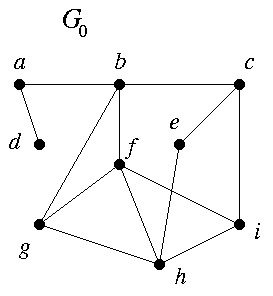
For Mon. 1/26: Read Sections 1.1, 1.2.
Do for discussion Thurs. 1/29:
Sect. 1.1, ## 1, 2, 4(a-c), 6, 9(a).
Sect. 1.2, # 1, 5, 7, 8.
# B3(a).
Do for discussion Fri. 1/30:
Sect. 1.2, ## 2, 3.
## B1, B2, B3(b).
Hand in Mon. 2/2:
Sect. 1.1, ## 3, 4(d), 5, 7, 8, 9(b).
Sect. 1.2, ## 4, 6.
# B4.
Definitions will be found on the announcements page.

B1. This concerns Theorem 1.1.2 and the example G0. I'll follow the book's notation. NOTE: There are some errors in this question. The corrected version is Problem # BB1 in HW Set IIa.)
The sequence
(S1) (4, 4, 4, 3, 3, 3, 2, 2, 1)
is known to be graphic, because it is the degree sequence of G0. From (S1) the rule of Theorem 1.1.2 gives
(S2) (3,3,2,2,3,2,2,1).
B2. In which graphs is the whole vertex set V the only separating set?
B3. In G2 from Homework I, find the values of (a) kappa(1, 5), (b) kappa(2, 6). Use Menger's Vertex Theorem to prove you are correct: i.e., find the internally disjoint paths that the theorem tells us exist.
B4. The same as B3, but for kappa(v3, v5) in G3 from Homework I.